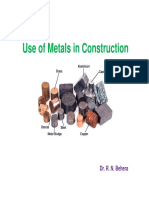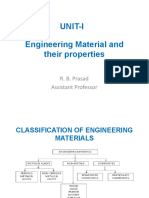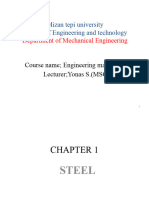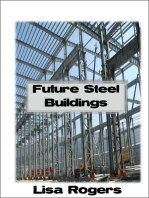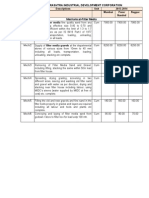0 ratings0% found this document useful (0 votes)
47 viewsUnit 2steel Alloy
Unit 2steel Alloy
Uploaded by
Ln VedanayagamSteel is an alloy of iron and carbon that can be strengthened by adding other metals like cobalt, copper, chromium, nickel, and manganese. Structural steel is used in construction and comes in hot rolled and cold formed sections. It has advantages like strength, constructability, and recyclability but requires protection from corrosion. Steel is also made into sheets for uses like machinery, ductwork, and roofing. Steel sheeting comes in types like stainless, galvanized, carbon, and hot and cold rolled varieties.
Copyright:
© All Rights Reserved
Available Formats
Download as PPTX, PDF, TXT or read online from Scribd
Unit 2steel Alloy
Unit 2steel Alloy
Uploaded by
Ln Vedanayagam0 ratings0% found this document useful (0 votes)
47 views29 pagesSteel is an alloy of iron and carbon that can be strengthened by adding other metals like cobalt, copper, chromium, nickel, and manganese. Structural steel is used in construction and comes in hot rolled and cold formed sections. It has advantages like strength, constructability, and recyclability but requires protection from corrosion. Steel is also made into sheets for uses like machinery, ductwork, and roofing. Steel sheeting comes in types like stainless, galvanized, carbon, and hot and cold rolled varieties.
Original Description:
Alloy
Copyright
© © All Rights Reserved
Available Formats
PPTX, PDF, TXT or read online from Scribd
Share this document
Did you find this document useful?
Is this content inappropriate?
Steel is an alloy of iron and carbon that can be strengthened by adding other metals like cobalt, copper, chromium, nickel, and manganese. Structural steel is used in construction and comes in hot rolled and cold formed sections. It has advantages like strength, constructability, and recyclability but requires protection from corrosion. Steel is also made into sheets for uses like machinery, ductwork, and roofing. Steel sheeting comes in types like stainless, galvanized, carbon, and hot and cold rolled varieties.
Copyright:
© All Rights Reserved
Available Formats
Download as PPTX, PDF, TXT or read online from Scribd
Download as pptx, pdf, or txt
0 ratings0% found this document useful (0 votes)
47 views29 pagesUnit 2steel Alloy
Unit 2steel Alloy
Uploaded by
Ln VedanayagamSteel is an alloy of iron and carbon that can be strengthened by adding other metals like cobalt, copper, chromium, nickel, and manganese. Structural steel is used in construction and comes in hot rolled and cold formed sections. It has advantages like strength, constructability, and recyclability but requires protection from corrosion. Steel is also made into sheets for uses like machinery, ductwork, and roofing. Steel sheeting comes in types like stainless, galvanized, carbon, and hot and cold rolled varieties.
Copyright:
© All Rights Reserved
Available Formats
Download as PPTX, PDF, TXT or read online from Scribd
Download as pptx, pdf, or txt
You are on page 1of 29
II – STEEL ALLOYS AND
INNOVATIONS IN STEEL INDUSTRIES
INTRODUCTION:
Steel is an alloy of iron and carbon. Pure
iron without any carbon content is not very
strong but when alloyed with carbon its
strength can be increased remarkably. Iron is
alloyed with carbon called steel.
STEEL ALLOY-DEFINITION:
Steel is alloyed with other non ferrous
metals like copper, nickel etc the resulting
products are called steel alloy. Some of the
common steel alloys are,
• Cobalt steel: This alloy is formed by adding cobalt to high carbon steel.
This alloy remains hard and tough even at hot condition. Cobalt helps
maintain magnetic effect permanently in the steel. Alloy containing 5-12%
cobalt it’s very much used for high speed cutting tools, 35% of cobalt in
high carbon steel is used for making permanent magnets.
• Copper steel: This alloy consist of copper to the extent of about 0.15 –
0.25%. This alloy can resist effects of atmospheric agencies in a better way
ordinary carbon steel.
• Chrome nickel steel: This alloy is made by adding 0.55 – 1.75% chromium
and 1.10 – 3.75% of nickel to steel having carbon content varying from
0.17 – 0.43%. This alloy is durable, tough and highly resistant to dynamic
stress. It possesses high tensile strength. This alloy is used for bearing
gears, aeroplane and various engine parts.
• Chromium steel: It is also known as chrome steel. It is prepared by adding
0.7-1.2% of chromium to steel containing carbon content varying from
0.17-0.55%. This alloy can withstand impact, shock and abrasion very
effectively. Elastic limit of this alloy is very high. It is used for coil spring.
Ball bearing, files cutting tools etc.
• Chromium – molybdenum steel: This alloy contains 0.4-1.1% chromium
and 0.2-0.4% of molybdenum is added to the steel having a carbon
content of 0.2-0.5%. This alloy is hard, tough and strong. It is very much
used in air craft industry, oil industry etc.
• Manganese steel: This alloy contains manganese 1.5-1.9% and steel
containing carbon content varying from 0.3-0.5%. It is hard, strong, fairly
ductile alloy. It possesses excellent resistance against abrasion. Its
coefficient of expansion is low. This alloy is used for gears, railway points
and crossing etc.
• Tungsten steel: Steel having a carbon content of 0.5-1% is alloyed with 5-
7% of tungsten. It is a hard alloy which can maintain cutting edges sharp
even at very high temperature. This alloy is used for cutting tools and
drillings etc.
• Vanadium steel: This alloy is formed by alloying about 0.2% of vanadium
with steel. This alloy is ductile and has quite high strength. It is used for
spring, auto mobile parts etc.
• Silicon steel: This alloy is made by alloying silicon with steel. This alloy is
very tough. Steel alloy containing 3.5% silicon can hardly be bending up to
90 degree. More than 4% silicon develops brittleness in the alloy. It can be
easily made magnetic and with equal ease, it can be demagnetized. This
alloy is very much used for transformer cores.
• Stainless steel: It is an alloy of iron which is characterized by its
pronounced resistance to corrosion. It is steel having a low carbon content
and chromium content of over 12%.
The following is a range of IMPROVED
PROPERTIES in alloy steels (as
compared to carbon steels):
strength, hardness, toughness, wear resistance,
corrosion resistance, harden ability, and hot
hardness. To achieve some of these improved
properties the metal may require heat
treating.
STRUCTURAL STEEL
• Structural steel is a steel construction material,
a profile, formed with a specific shape or cross
section and certain standards of chemical
composition and mechanical properties.
• The shape, size, composition, strength, storage,
etc., is regulated in most industrialized countries.
Structural steel is used in bridges, buildings and
other types of structures throughout the world.
• Structural steel is used in bridges, buildings and
other types of structures throughout the world.
• Characteristics:- Structural steel differs from concrete in its attributed
compressive strength as well as tensile strength.
• Strength:- Having high strength, stiffness, toughness, and ductile
properties, structural steel is one of the most commonly used materials in
commercial and industrial building construction.
• Constructability:- Structural steel can be developed into nearly any shape,
which are either bolted or welded together in construction. Structural
steel can be erected as soon as the materials are delivered on site,
whereas concrete must be cured at least 1–2 weeks after pouring before
construction can continue, making steel a schedule-friendly construction
material.
• Fire resistance:- Steel is inherently a noncombustible material. However,
when heated to temperatures seen in a fire scenario, the strength and
stiffness of the material is significantly reduced. The International Building
Code requires steel be enveloped in sufficient fire-resistant materials,
increasing overall cost of steel structure buildings.
• Corrosion:- Steel, when in contact with water, can corrode, creating a
potentially dangerous structure. Measures must be taken in structural
steel construction to prevent any lifetime corrosion. The steel can be
painted, providing water resistance. Also, the fire resistance material used
to envelope steel is commonly water resistant.
Advantages –
• to using structural steel are that it is inexpensive to manufacture.
• requires less maintenance.
• is cheaper to insure than other traditional building methods.
• As long as it is protected from rust, the steel maintains its strength
indefinitely.
• it can be recycled.
• Has low strength to weight ratio than concrete.
Disadvantages –
• include higher transportation costs due to its weight.
• and that without proper maintenance, it is prone to rust
or corrosion.
• It also requires large amounts of energy to produce.
Some examples of famous landmarks made
using structural steel include the Seagram Building, the Eiffel Tower,
and the Brooklyn Bridge.
STRUCTURAL STEEL PROTECTION:
Passive fire protection materials insulate steel structures from the effects of the high temperatures
that may be generated in fire.
They can be divided into two types, non-reactive, of which the most common types
are boards and sprays, and reactive, of which thin film in tumescent coatings are the most common
example. Thin film in tumescent coatings in turn can be either on-site or off-site applied.
1) In tumescent Coatings
(They are paint like materials which are inert at low temperatures but which provide insulation as a
result of a complex chemical reaction at temperatures of approximately 200-250°C.)
Thin film in tumescent coatings
Off site applied in tumescent coatings
Thick film in tumescent coatings
2) Boards
3) Sprays
4) Flexible blanket systems
5) Concrete encasement
6) Partial protection
Block in filled columns
Shelf angle floor beams
Slim floor beams
Web in filled columns
Composite beams and columns with full and partial concrete encasement.
Thin film in tumescent coating
STRUCTURAL STEEL SECTIONS:
The two main families of structural steel
members are the following,
• Hot rolled steel sections
• Cold formed steel sections
STEEL SHEETING:
• A steel sheet is a unit of steel that has been
formed into a relatively flat panel or sheet.
• Made from an alloy of iron
and tin, steel sheets are available in both flat
and coiled varieties.
• Depending on the thickness of the steel, the
sheets can be cut to size using simple tin snip
or steel shears.
Uses:
• Steel sheets can be used in many different applications.
They are used in the automotive industry for
fabricating vehicle components, and are also used in
aerospace construction and also in construction
industry.
• Some form of steel sheet is used to fabricate the casing
for most machinery, and can be found on many
electrical components.
• Sheet metal roofs are popular, and may be fabricated
from stainless or galvanized steel.
• Steel sheets are also used to make ductwork, which
transports air from heating and cooling equipment.
These sheets can also be used for decorative or finish
purposes both inside and outside of a building.
TYPES OF STEEL SHEETING:
Steel Sheet Metal:
A stainless steel sheet is a type of sheet metal made from an alloy of steel and chromium.
Though the thickness of a stainless steel sheet can vary, it is generally thicker than metal leaf or foil, but
thinner than a metal plate.
A galvanized coating is not a permanent solution. The protective layer of a galvanized steel sheet will corrode
eventually, leaving the steel unprotected and prone to oxidization.
Carbon Steel Sheet:
The pressure from the rollers squeezes the carbon steel stock into more manageable forms, such as flat sheets,
strips, bars or rods.
While the steel contains properties that work well in manufacturing a variety of goods, it is most frequently
made into flat-rolled sheets or strips of steel.
Cold Rolled Steel Sheet:
The final cold-rolled steel stock may be manufactured in the form of sheets, strips, bars, or other forms.
Cold-rolled steel products feature a variety of attributes suitable in a wide range of applications.
When the steel goes through the cold mill process, it is pressed into a pre-ordered gauge for further finishing.
Hot Rolled Steel Sheet:
Most steel that is used outdoors is galvanized, which increases its ability to resist rusting and corrosion.
Any type of steel object, from a steel plate to steel sheet metal can undergo galvanization under the right
conditions.
The hot galvanizing process is an important part of steel manufacturing, and offers many advantages.
Rolled steel
Coated Steel Sheet
• Cold-rolled steel is subject to rust and
corrosion over time due to exposure to
moisture or chemicals.
• Galvanized steel sheets have
been coated with zinc through an
electroplating process, which adds a layer of
corrosion-resistance.
• Metalworkers use these sheets to create
artwork and architectural elements.
Galvanized steel sheet
• It is a sheet of steel that has been galvanized in order
to help prevent corrosion.
• It can be used in a variety of applications including in
furniture, cars, or in making tool boxes.
• By putting on a barrier coat to the steel, a galvanized
steel sheet is able to better resist the destructive forces
acting against it. It must be noted, however, that this
coating can deteriorate over time.
• The process of producing a galvanized steel sheet
usually involves nothing more than dipping that sheet
into very hot zinc.
Perforated sheet metal
• It is a sheet metal in which perforations have
been blanked out of the metal.
• This type of metal is usually composed of carbon
steel or stainless steel.
• It allows for a variety of standard designs, making
it easy to use for a number of purposes.
• The majority of perforated sheet metal comes in
sheets between 16 and 24 gauge, which is
perfect for designing.
STAINLESS STEEL
• In metallurgy, stainless steel, also known as inox
steel or inox from French "inoxydable", is
a steel alloy with a minimum of
10.5% chromium content by mass.
• Stainless steel does not readily corrode, rust or stain
with water as ordinary steel does. However, it is not
fully stain-proof in low-oxygen, high-salinity, or poor
air-circulation environments. There are different grades
and surface finishes of stainless steel to suit the
environment the alloy must endure. Stainless steel is
used where both the properties of steel and corrosion
resistance are required.
PROPERTIES:
• Oxidation
• Acids
• Bases
• Organics
• Electricity and magnetism
APPLICATIONS:
Stainless steel’s resistance to corrosion and staining, low maintenance and
familiar lustre make it an ideal material for many applications. There are
over 150 grades of stainless steel, of which fifteen are most commonly
used.
Some automotive manufacturers use stainless steel as decorative highlights in
their vehicles.
Architecture
Stainless steel is used for buildings for both practical and aesthetic reasons.
Stainless steel was in vogue during the art deco period. The most famous
example of this is the upper portion of the Chrysler Building (pictured).
Some diners and fast-food restaurants use large ornamental panels and
stainless fixtures and furniture. Because of the durability of the material,
many of these buildings retain their original appearance.
Type 316 stainless is used on the exterior of both the Petronas Twin
Towers and the Jin Mao Building, two of the world's tallest skyscrapers.
The Parliament House of Australia in Canberra has a stainless steel flagpole
weighing over 220 tonnes (240 short tons).
The aeration building in the Edmonton Composting Facility, the size of 14
hockey rinks, is the largest stainless steel building in North America.
Bridges
Cala Galdana Bridge in Minorca (Spain) was the first stainless steel road bridge.
Sant Fruitos Pedestrian Bridge (Catalonia, Spain), arch pedestrian bridge.
Padre Arrupe Bridge (Bilbao, Spain) links the Guggenheim museum to the University of
Deusto.
Monuments and sculptures
The Unisphere, constructed as the theme symbol of the 1964-5 World's Fair in New
York City, is constructed of Type 304L stainless steel as a sphere with a diameter of
120 feet, or 36.57 meters.
The Gateway Arch (pictured) is clad entirely in stainless steel: 886 tons (804 metric
tonnes) of 0.25 in (6.4 mm) plate, #3 finish, type 304 stainless steel.[19]
The United States Air Force Memorial has an austenitic stainless steel structural skin.
The Atomium in Brussels, Belgium was renovated with stainless-steel cladding in a
renovation completed in 2006; previously the spheres and tubes of the structure
were clad in aluminium.
The Cloud Gate sculpture by Anish Kapoor, in Chicago US.
The Sibelius monument in Helsinki, Finland, is made entirely of stainless steel tubes.
The Kelpies in Falkirk, Scotland.
The Man of Steel (sculpture) under construction in Rotherham, England.
Other:
Automotive bodies
The Allegheny Ludlum Corporation worked with Ford on various concept cars with stainless steel bodies from the 1930s
through the 1970s, as demonstrations of the material's potential. The 1957 and 1958Cadillac Eldorado Brougham
had a stainless steel roof. In 1981 and 1982, the DeLorean DMC-12 production automobile used stainless steel
body panels over a glass-reinforced plastic monocoque. Intercity buses made by Motor Coach Industries are
partially made of stainless steel. The aft body panel of the Porsche Cayman model (2-door coupe hatchback) is
made of stainless steel. It was discovered during early body prototyping that conventional steel could not be
formed without cracking (due to the many curves and angles in that automobile). Thus, Porsche was forced to use
stainless steel on the Cayman.
Passenger rail cars
Rail cars have commonly been manufactured using corrugated stainless steel panels (for additional structural strength).
This was particularly popular during the 1960s and 1970s, but has since declined. One notable example was the
early Pioneer Zephyr. Notable former manufacturers of stainless steel rolling stock included the Budd
Company (USA), which has been licensed to Japan's Tokyu Car Corporation, and the Portuguese
company Sorefame. Many railcars in the United States are still manufactured with stainless steel, unlike other
countries who have shifted away.
Aircraft
Budd also built an airplane, the Budd BB-1 Pioneer, of stainless steel tube and sheet, which is on display at the Franklin
Institute.
The American Fleetwings Sea Bird amphibious aircraft of 1936 was also built using a spot-welded stainless steel hull.
The Bristol Aeroplane Company built the all-stainless steel Bristol 188 high-speed research aircraft, which first flew in
1963.
The use of stainless steel in mainstream aircraft is hindered by its excessive weight compared to other materials, such
as aluminum.
Jewelry
Valadium, a stainless steel and 12% nickel alloy is used to make class and military rings. Valadium is usually silver-toned,
but can be electro-charged to give it a gold tone. The gold tone variety is known as Sun-lite Valadium.
TYPES OF STAINLESS STEEL
• Pipes and fittings made of stainless steel
• Stainless steels are also classified by their crystalline structure:
• Austenitic, or 200 and 300 series, stainless steels have an austenitic
crystalline structure, which is a face-centered cubic crystal structure.
• Super austenitic stainless steels, such as alloy AL-6XN and 254SMO, exhibit
great resistance to chloride pitting and crevice corrosion because of
high molybdenum content (>6%) and nitrogen additions, and the higher
nickel content ensures better resistance to stress-corrosion cracking
versus the 300 series.
• Ferritic stainless steels generally have better engineering properties than
austenitic grades, but have reduced corrosion resistance, because of the
lower chromium and nickel content. They are also usually less expensive
• Swiss Army knives are made of martensitic stainless steel.
• Martensitic stainless steels are not as corrosion-resistant as the other two
classes but are extremely strong and tough, as well as highly machinable,
and can be hardened by heat treatment.
• Precipitation-hardening martensitic stainless steels have corrosion
resistance comparable to austenitic varieties, but can
be precipitation hardened to even higher strengths than the other
martensitic grades. The most common, 17-4PH, uses about 17%
chromium and 4% nickel.
• Duplex stainless steels have a mixed microstructure of austenite and
ferrite, the aim usually being to produce a 50/50 mix, although in
commercial alloys the ratio may be 40/60.
• Duplex grades are characterized into groups based on their alloy
content and corrosion resistance.
• Lean duplex refers to grades such as UNS S32101 (LDX 2101),
S32304, and S32003.
• Standard duplex is 22% chromium with UNS S31803/S32205 known
as 2205 being the most widely used.
• Super duplex is by definition a duplex stainless steel with a Pitting
Resistance Equivalent
• Hyper duplex refers to duplex grades with a PRE > 48 and at the
moment only UNS S32707 and S33207 are available on the market.
You might also like
- 19 Composition Rules PDFDocument1 page19 Composition Rules PDFengrl2979367% (3)
- Lisa Gallery Selection CriteriaDocument7 pagesLisa Gallery Selection Criteriagetrealperth0% (1)
- The Maxx: Maxximized, Vol. 1 PreviewDocument10 pagesThe Maxx: Maxximized, Vol. 1 PreviewGraphic Policy100% (1)
- Arts and Crafts of MindanaoDocument30 pagesArts and Crafts of MindanaoShiena EndayaNo ratings yet
- Tensile Strength of SteelDocument20 pagesTensile Strength of SteelChelsiemea VargasNo ratings yet
- Steel in Industrial Construction: Jyoti Chaurasiya Priyanka Siddharth Agarwal Zeenat ParveenDocument14 pagesSteel in Industrial Construction: Jyoti Chaurasiya Priyanka Siddharth Agarwal Zeenat ParveenSanjay SaxenaNo ratings yet
- Steel and Steel Making: Fact: Carbon Steels Make Up About 90% of All Steel ProductionDocument6 pagesSteel and Steel Making: Fact: Carbon Steels Make Up About 90% of All Steel ProductionSAMANTHA SARAH PURBANo ratings yet
- Chapter 2 MetalsDocument40 pagesChapter 2 Metalsaman sudiNo ratings yet
- BJTC 2023 Construction Technology: Chapter 5 - Steel and Other MetalsDocument50 pagesBJTC 2023 Construction Technology: Chapter 5 - Steel and Other MetalsHermioneNo ratings yet
- Use of Metals in Construction: Dr. R. N. BeheraDocument46 pagesUse of Metals in Construction: Dr. R. N. BeheraRishabh SinghNo ratings yet
- 4 Types of SteelDocument7 pages4 Types of SteelTou ChéNo ratings yet
- Steel As A Building MaterialDocument11 pagesSteel As A Building MaterialPriyank Soni100% (1)
- Structural Steel (Sheet 1)Document24 pagesStructural Steel (Sheet 1)Ramya shree kNo ratings yet
- Lecture 2 - ECE 2215 PDFDocument24 pagesLecture 2 - ECE 2215 PDFRando ClintonNo ratings yet
- Building Construction and Material - VDocument20 pagesBuilding Construction and Material - Vkushagra agrawalNo ratings yet
- SteelDocument34 pagesSteelSumit GhartimagarNo ratings yet
- MetalsDocument8 pagesMetalsAnna KateurinaNo ratings yet
- Metal: Common Metals in The Construction Industry Carbon SteeDocument3 pagesMetal: Common Metals in The Construction Industry Carbon SteeChris Michelle JapinNo ratings yet
- Engineering Material and Their Properties Unit-I: R. B. Prasad Assistant ProfessorDocument22 pagesEngineering Material and Their Properties Unit-I: R. B. Prasad Assistant ProfessorDeekshaomarNo ratings yet
- Hot Rolled SteelDocument2 pagesHot Rolled SteelabhishekNo ratings yet
- Metals 18-19Document35 pagesMetals 18-19ZACHARIE TUYUBAHENo ratings yet
- Metal & SteelDocument37 pagesMetal & Steel2023276706No ratings yet
- RSW BT YongDocument10 pagesRSW BT Yongfraniancis0922No ratings yet
- Structural SteelDocument26 pagesStructural Steeldiya.nithanya.barch22No ratings yet
- Types of Steel and MetalDocument11 pagesTypes of Steel and MetalJohanssen ManlapuzNo ratings yet
- Thesis 35Document26 pagesThesis 35Md. Sayem ShahriarNo ratings yet
- MetalsDocument58 pagesMetalsAkanksha VermaNo ratings yet
- SteelDocument30 pagesSteelArunagiriNo ratings yet
- Chem 114 Metals 1Document44 pagesChem 114 Metals 1Elein MarceloNo ratings yet
- Protective CoatingsDocument203 pagesProtective CoatingsGopalakrishnan KuppuswamyNo ratings yet
- 9b... 2b To 5bDocument7 pages9b... 2b To 5bCubillan, Kenneth M.No ratings yet
- Carbon SteelDocument9 pagesCarbon SteelArfanAliNo ratings yet
- Dcq10033 Topic 1 Metal and Non MetalDocument46 pagesDcq10033 Topic 1 Metal and Non Metalfarhan selamatNo ratings yet
- Mechanical Engy MaterialsDocument37 pagesMechanical Engy MaterialsKouame AdjepoleNo ratings yet
- Construction Materials AssignmentDocument45 pagesConstruction Materials AssignmentDB FasikaNo ratings yet
- Lesson 4. Steel Construction MaterialsDocument25 pagesLesson 4. Steel Construction MaterialsJay-r MiñozaNo ratings yet
- Chapter One - Introduction To Steel StructuresDocument8 pagesChapter One - Introduction To Steel StructuresJohn Philip Molina NuñezNo ratings yet
- Unit 1Document11 pagesUnit 1Himal AryalNo ratings yet
- Format Classtest 2 SteelDocument5 pagesFormat Classtest 2 SteelVaibhav BhosaleNo ratings yet
- Control of PropertiesDocument65 pagesControl of PropertiesJezzrel Xandy BalmesNo ratings yet
- Ferrous-Non Ferrous and Corrosion - 11!08!2011Document6 pagesFerrous-Non Ferrous and Corrosion - 11!08!2011Rohan RamguttyNo ratings yet
- Unit 3 PDFDocument25 pagesUnit 3 PDFharshitha2005sriNo ratings yet
- Building Construction & Materials - V: Steel As Construction Material Adharsh.S GCAD/18/304Document11 pagesBuilding Construction & Materials - V: Steel As Construction Material Adharsh.S GCAD/18/304Adharsh SelvarajNo ratings yet
- Steel PipesDocument2 pagesSteel PipesArfanAliNo ratings yet
- Types of Welding in ShipbuildingDocument30 pagesTypes of Welding in ShipbuildingPranjyoti SaikiaNo ratings yet
- Amt 4201 Final Module 1Document20 pagesAmt 4201 Final Module 1Mae EspinosaNo ratings yet
- 6 - Iron Types - ApplicationsDocument18 pages6 - Iron Types - ApplicationsZhiwar oramariNo ratings yet
- Material II ppt-1Document46 pagesMaterial II ppt-1wabdushukurNo ratings yet
- Introduction To The Design of Structural SteelDocument18 pagesIntroduction To The Design of Structural SteelRoan SaldivarNo ratings yet
- Types of Steel According To Deoxidation PracticeDocument2 pagesTypes of Steel According To Deoxidation PracticeSyed Raheel AdeelNo ratings yet
- Chapter 1 Introduction To Steel DesignDocument33 pagesChapter 1 Introduction To Steel DesignRami Demachki100% (1)
- Protection and Finishes of SteelDocument10 pagesProtection and Finishes of Steeltedime3577No ratings yet
- Metallographic Properties: 1. Mild SteelsDocument4 pagesMetallographic Properties: 1. Mild SteelsmuralidharanNo ratings yet
- Material Science NotesDocument11 pagesMaterial Science NotesRyan Ryan RyanNo ratings yet
- ReinforcementDocument6 pagesReinforcementakinyemioaNo ratings yet
- Group 5 - Written ReportDocument17 pagesGroup 5 - Written ReportVeeNo ratings yet
- Crisp Notes of Material in IndustryDocument17 pagesCrisp Notes of Material in IndustryInceptionNo ratings yet
- Structure and PropertiedDocument43 pagesStructure and PropertiedJalaj GaurNo ratings yet
- Ap Ac NotesDocument8 pagesAp Ac NotesAnju GuptaNo ratings yet
- Material Selection Consideration For ReactorsDocument6 pagesMaterial Selection Consideration For ReactorsMiera Yushira YusoffNo ratings yet
- Stainless Steel by M SqureDocument15 pagesStainless Steel by M SqureMeghaprakashNo ratings yet
- DeconstructionDocument27 pagesDeconstructionLn VedanayagamNo ratings yet
- Competition Brief: The Idea of A Renaissance PavilionDocument8 pagesCompetition Brief: The Idea of A Renaissance PavilionLn VedanayagamNo ratings yet
- Virtual Organizations: An OverviewDocument6 pagesVirtual Organizations: An OverviewLn VedanayagamNo ratings yet
- British Museum Greek ArchitectureDocument10 pagesBritish Museum Greek ArchitectureLn VedanayagamNo ratings yet
- Cyber Security Issues and RecommendationsDocument6 pagesCyber Security Issues and RecommendationsLn VedanayagamNo ratings yet
- Swings Sand Box Slide Jungle Gym Play House or Cabin: Shrubs, Too Come in Different Growth FormsDocument1 pageSwings Sand Box Slide Jungle Gym Play House or Cabin: Shrubs, Too Come in Different Growth FormsLn VedanayagamNo ratings yet
- Cyber Security Issues and RecommendationsDocument6 pagesCyber Security Issues and RecommendationsLn VedanayagamNo ratings yet
- Unit 2Document20 pagesUnit 2Ln VedanayagamNo ratings yet
- Mental Ability Question & Answers: A. BirdsDocument16 pagesMental Ability Question & Answers: A. BirdsLn VedanayagamNo ratings yet
- Dept Exam Dec 2018 Final KeyDocument111 pagesDept Exam Dec 2018 Final KeyLn VedanayagamNo ratings yet
- Building Materials Unit - Ii Clay ProductsDocument31 pagesBuilding Materials Unit - Ii Clay ProductsLn VedanayagamNo ratings yet
- Buliding Materials Unit 5 Glass: Done by AbinayaDocument9 pagesBuliding Materials Unit 5 Glass: Done by AbinayaLn VedanayagamNo ratings yet
- 34 2012 Not Eng JR ArchDocument9 pages34 2012 Not Eng JR ArchLn VedanayagamNo ratings yet
- Unit 5 Roofing MaterialsDocument20 pagesUnit 5 Roofing MaterialsLn VedanayagamNo ratings yet
- For QuoteDocument1 pageFor QuoteChinangNo ratings yet
- Jami Al-MawaziniDocument12 pagesJami Al-Mawaziniellenhamed.officialNo ratings yet
- Nippon Paint Colour ChartDocument8 pagesNippon Paint Colour ChartRobinson DimaculanganNo ratings yet
- Judith Adler - Revolutionary ArtDocument19 pagesJudith Adler - Revolutionary ArtJosé Miguel CuretNo ratings yet
- Roman GubernDocument125 pagesRoman Gubernedgardoalbornoz_70% (1)
- 4552 Pattern PDFDocument24 pages4552 Pattern PDFBruna Lucatelli MartinsNo ratings yet
- Post-Modern Architecture: History of Architecture-III Class - 1Document23 pagesPost-Modern Architecture: History of Architecture-III Class - 1Prakriti GoelNo ratings yet
- PCB Production MethodsDocument56 pagesPCB Production Methodsaman432100% (1)
- Art 002 ReviewerDocument5 pagesArt 002 Reviewerpaopao.backup1No ratings yet
- Ekphrastic PoetryDocument5 pagesEkphrastic PoetryEddyOmburahNo ratings yet
- Jotafloor Rapid Dry: Technical Data SheetDocument1 pageJotafloor Rapid Dry: Technical Data SheetTamerTamerNo ratings yet
- Halftone Process/Screening: PMT 352 - Dip. 05 Printing Technology Department FSSR, Uitm, Shah AlamDocument15 pagesHalftone Process/Screening: PMT 352 - Dip. 05 Printing Technology Department FSSR, Uitm, Shah AlamBadri JaafarNo ratings yet
- 01-M115 Iss 2 (BS en 1290 - Electromagnet, (Fluorescent) )Document3 pages01-M115 Iss 2 (BS en 1290 - Electromagnet, (Fluorescent) )DeepakNo ratings yet
- 2022-09-12 The New YorkerDocument86 pages2022-09-12 The New YorkerKate AprelskyNo ratings yet
- FloDocument28 pagesFloZoran DanilovNo ratings yet
- Corrosion Protection of Ships: RecommendedDocument38 pagesCorrosion Protection of Ships: RecommendedMuhammad adi100% (1)
- DSR 2013-14 - E&mDocument44 pagesDSR 2013-14 - E&mAHMED SOHEL50% (2)
- Metric Conversion Guide PDFDocument6 pagesMetric Conversion Guide PDFGuthrie WardNo ratings yet
- May JuneDocument2 pagesMay JuneRenee GirardNo ratings yet
- 10 Jotun Solutions To Oil & GasDocument74 pages10 Jotun Solutions To Oil & GasAntony Bruno Genewin100% (2)
- Mock-Nat HumanitiesDocument50 pagesMock-Nat HumanitiesShaira MejaresNo ratings yet
- Analyzing PictureDocument3 pagesAnalyzing Pictureapi-364297017No ratings yet
- Fine Art - April 2021Document18 pagesFine Art - April 2021ArtdataNo ratings yet
- Application Study On Soft Decoration Materials in Modern Living SpaceDocument3 pagesApplication Study On Soft Decoration Materials in Modern Living SpaceafenuvonadebayorNo ratings yet
- The Faces of BélmezDocument3 pagesThe Faces of BélmezRafael FabroNo ratings yet
- Alfred Stieglitz Photographer's PresentationDocument8 pagesAlfred Stieglitz Photographer's PresentationRahulNo ratings yet









